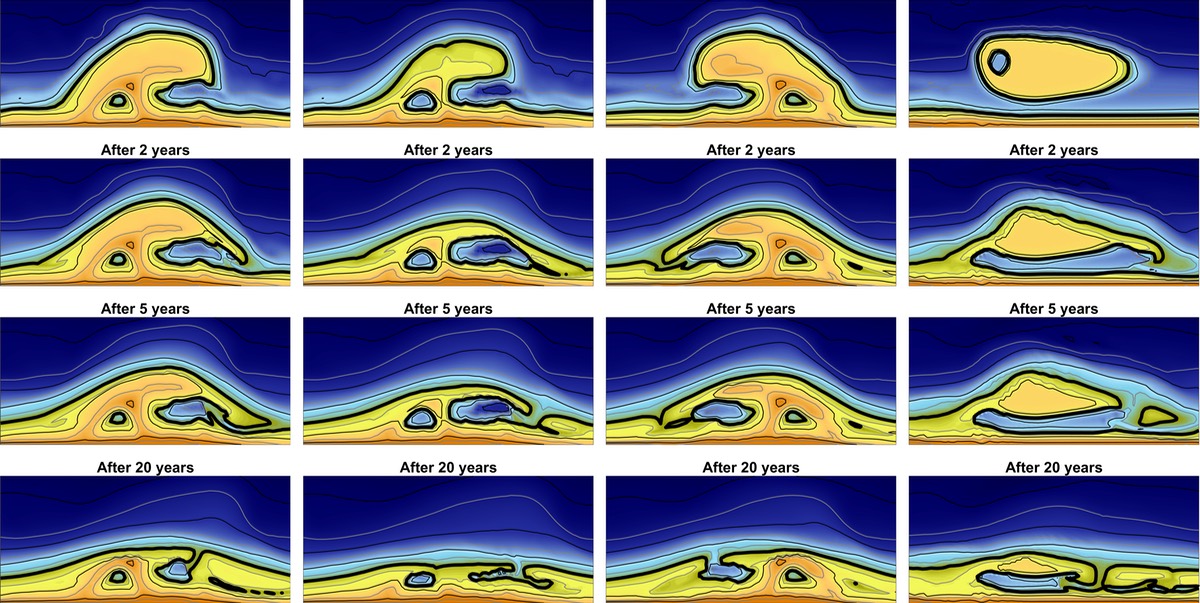Community base for interdisciplinary research on coastal evolution
Downloads
DOI:
https://doi.org/10.47982/rius.7.135Abstract
A common measure to mitigate erosion along sandy beaches is the implementation of sand nourishments. The design and societal acceptance of such a soft mitigation measure demands information on the expected evolution at various time scales ranging from a storm event to multiple decades. Process-based morphodynamic models are increasingly applied to obtain detailed information on temporal behaviour. This paper discusses the process-based morphodynamic model applied to the Sand Motor and how the morphodynamic forecasts have benefitted from the findings of an interdisciplinary research program called NatureCoast. The starting point is the morphodynamic prediction of the Sand Motor made for an Environmental Impact Assessment in 2008 before construction began. After the construction, the model computations were optimized using the first-year field measurements and insights by applying advanced model features. Next, an integrated model was developed that seamlessly predicts the morphodynamics in both the subaqueous and subaerial domains of the Sand Motor. Decadal predictions illustrate the need to be able to resolve the marine and aeolian processes simultaneously in one modelling framework in the case of dynamic coastal landscapes. Finally, a novel morphodynamic acceleration technique was developed that allows for predicting the morphodynamics for multiple decades while incorporating storm events in one simulation. Combining the above-mentioned developments has led to a unique, open-source, process-based landscape tool for (complex) coastal sandy systems, which can stimulate further collaboration between research communities. Moreover, this work demonstrates the evolution from mono- to interdisciplinary forecasts of coastal evolution.
How to Cite
Published
Issue
Section
References
de Schipper, M. A., de Vries, S., Ruessink, G., de Zeeuw, R. C., Rutten, J., van Gelder-Maas, C., & Stive, M. J. F. (2016). Initial spreading of a mega feeder nourishment: Observations of the Sand Engine pilot project. Coastal Engineering, 111, 23–38. https://doi.org/10.1016/j.coastaleng.2015.10.011
de Vriend, H. J., van Koningsveld, M., Aarninkhof, S. G. J., de Vries, M. B., & Baptist, M. J. (2015). Sustainable hydraulic engineering through building with nature. Journal of Hydro-Environment Research, 9(2), 159–171. https://doi.org/10.1016/j.jher.2014.06.004
Hoonhout, B., & de Vries, S. (2017). Aeolian sediment supply at a mega nourishment. Coastal Engineering, 123, 11–20. https://doi.org/10.1016/j.coastaleng.2017.03.001
Luijendijk, A. P., Ranasinghe, R., de Schipper, M. A., Huisman, B. A., Swinkels, C. M., Walstra, D. J. R., & Stive, M. J. F. (2017a). The initial morphological response of the Sand Engine: A process-based modelling study. Coastal Engineering, 119, 1–14. https://doi.org/10.1016/j.coastaleng.2016.09.005
Luijendijk, A., Velhorst, R., Hoonhout, B., de Vries, S., & Ranasinghe, R. (2017b). Integrated modelling of the morphological evolution of the sand engine mega-nourishment. In T. Aagaard, R. Deigaard, & D. Fuhrman (Eds.), Proceedings Coastal Dynamics 2017 (pp. 1874-1885). [157] http://coastaldynamics2017.dk/onewebmedia/157_Luijendijk_Arjen.pdf
Luijendijk, A., & van Oudenhoven, A. (Eds.). (2019). The Sand Motor: A Nature-Based Response to Climate Change: Findings and Reflections of the Interdisciplinary Research Program NatureCoast. Delft University Publishers - TU Delft Library.
Luijendijk, A., Schipper, M., & Ranasinghe, R. (2019a). Morphodynamic Acceleration Techniques for Multi-Timescale Predictions of Complex Sandy Interventions. Journal of Marine Science and Engineering, 7(3), 78. https://doi.org/10.3390/jmse7030078
Luijendijk, A. (2019b). Crossing borders in coastal morphodynamic modelling (Doctoral dissertation). Delft University of Technology. https://doi.org/10.4233/uuid:75ac8d9e-293f-4bff-90b3-467010352032
Stive, M. J. F., de Schipper, M. A., Luijendijk, A. P., Aarninkhof, S. G. J., van Gelder-Maas, C., van Thiel de Vries, J. S. M., de Vries, S., Henriquez, M., Marx, S., & Ranasinghe, R. (2013). A New Alternative to Saving Our Beaches from Sea-Level Rise: The Sand Engine. Journal of Coastal Research, 29 (5), 1001–1008. https://doi.org/10.2112/jcoastres-d-13-00070.1
Sutherland, J., Peet, A. H., & Soulsby, R. L. (2004). Evaluating the performance of morphological models. Coastal Engineering, 51(8–9), 917–939. https://doi.org/10.1016/j.coastaleng.2004.07.015
Taal, M.D., Löffler, M.A.M., Vertegaal, C.T.M., Wijsman, J.W.M., van der Valk, L. and Tonnon, P.K., 2016. Development of the Sand Motor: Concise report describing the first four years of the Monitoring and Evaluation Programme (MEP). Deltares. https://climate-adapt.eea.europa.eu/metadata/case-studies/sand-motor-2013-building-with-nature-solution-to-improve-coastal-protection-along-delfland-coast-the-netherlands/delfland-coast_document-1.pdf
Tonnon, P. K., van der Werf, J., Mulder, J. P. M., 2009. Morfologische berekeningen MER zandmotor. Deltares. https://repository.tudelft.nl/islandora/object/uuid:7dee6b8a-350b-4ddd-81e6-2093a2b624d2/datastream/OBJ2/download
van Puijenbroek, M. E. B., Limpens, J., de Groot, A. V., Riksen, M. J. P. M., Gleichman, M., Slim, P. A., van Dobben, H. F., & Berendse, F. (2017). Embryo dune development drivers: beach morphology, growing season precipitation, and storms. Earth Surface Processes and Landforms, 42(11), 1733–1744. https://doi.org/10.1002/esp.4144





